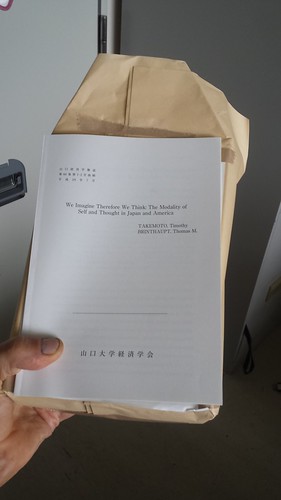Friday, September 29, 2017
We Imagine Therefore We Think: The Modality of Self and Thought in Japan and America

A brilliant Korean American researcher (Kim, 2002) found that self-talk improved American visual problem solving, and that preventing meaningful self-talk (by making the subjects repeat the alphabet) screwed things up, preventing Americans from solving problems. In East Asians however, she found that self-talk prevented visual problem solving, and that reciting the alphabet did not have a deleterious effect. She concluded that Asians are not thinking in language. We agree But Kim said little about the nature of East Asian thought.
In this paper we hypothesized that Asians do not talk to themselves but show themselves pictures or imagine. We call this a "Nacalian" (Lacan reversed) transformation and we give experimental data to support it.
Experiment 1)
We got Japanese to answer the second author's self-talk scale (Brinthaupt, Hein, & Kramer, 2009) (how much do you talk to yourself when….) and a modified version, the self-image scale (how much do you imagine things when…) and found that Japanese imagine more than they talk to themselves.
Experiment 2)
We reversed, or Nacalianly transformed, Kim's experiment (Kim, 2002), language for image, and found that imagination did not effect American subjects, neither for better, nor for worse if suppressed, but in Japanese imagining improved their ability to think up words, and repressing imagination prevented the same.
We argued that this lent evidence for our hypothesis that Japanese think by showing themselves images as oppose to talking to themselves.
We then discussed the implications for (A) the nature of thought and (B) Japanese culture.
A) Recently thought as self-speech has come under attack (Freud, Left Brain Right brain work, Libet, Nisbett and Wilson) from evidence to show that the reasons that people give for their behaviour are generally bogus, and thoughts are generated after the decision making event. Westerners think our thoughts cause our behaviour, but they do not. "Thoughts are the product, not the process of thought". So why do we have thoughts? Recent psychologists such as Johnathan Haidt (who is brilliant) argue that thought is excuse preparation. We talk to ourselves so as to work out justifications for our actions to say to others. Thinking is for speaking they claim.
However, if Japanese are thinking in pictures, then this communicative theory of thought seems untenable, at least in the Japanese case, since pictures are difficult to convey to others. So what is thought for? We argue that Higgins (1996) notion of thought as a way of becoming emotionally involved and therefore motivated by ones actions is appropriate explanation for thought. Both talking to oneself and showing oneself pictures is a way of mirroring oneself, like standing in front of mirror, or standing on scales (c.f. “the weigh yourself diet”). If you represent yourself to yourself, you try harder.
B) The Japanese are seen as lacking in thought, self and individuality because researchers are always paying attention solely to language. But if you look at the Japanese, their houses, cities, cars, clothes, TV, behaviour, then you see that they are bristling with creative, innovative thought, and individuality.
Brinthaupt, T. M., Hein, M. B., & Kramer, T. E. (2009). The self-talk scale: Development, factor analysis, and validation. Journal of personality assessment, 91(1), 82-92.
Haidt, J. (2012). The righteous mind: Why good people are divided by politics and religion. Vintage.
Kim, H. S. (2002). We talk, therefore we think? A cultural analysis of the effect of talking on thinking. Journal of personality and social psychology, 83(4), 828.
Higgins, E. T. (1996). The" self digest": self-knowledge serving self-regulatory functions. Journal of personality and social psychology, 71(6), 1062.
Takemoto, T. R., & Brinthaupt, T. M. (2017). We Imagine Therefore We Think: The Modality of Self and Thought in Japan and America. 山口経済学雑誌 (Yamaguchi Journal of Economics, Business Administrations & Laws), 65(7・8), 1–29. Retrieved from nihonbunka.com/docs/Takemoto_Brinthaupt.pdf
Perhaps the offprints will be valuable one day! They are free now.
Labels: japanese culture, Nacalian, nihonbunka, 日本文化
This blog represents the opinions of the author, Timothy Takemoto, and not the opinions of his employer.
